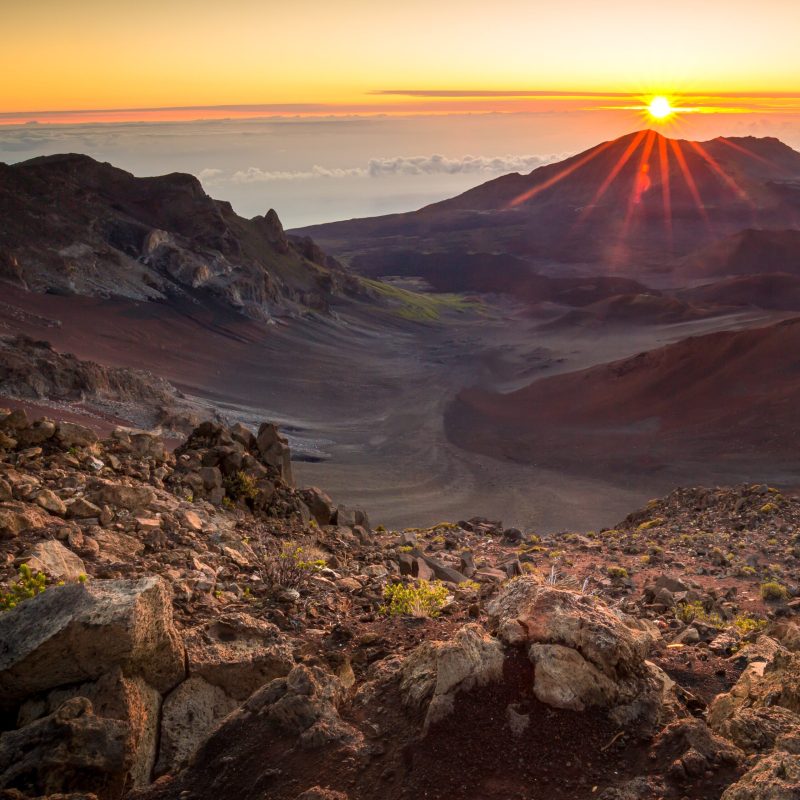
Hundreds of blanket-clad spectators huddle each morning atop Maui’s highest mountain — all eyes, cell phones, and cameras turned toward the east.
Videos by TravelAwaits
It is dark, cold, and oftentimes foggy and drizzling.
Still they stay, in anticipation of one of Maui’s premier attractions. And indeed, the sun rising over the craggy volcanic rocks of Haleakala is a sight to see.
It is also a perfect way to start your day at the spectacular Haleakala National Park.
And considering all there is to see, your 3 a.m. wake-up call for catching the sunrise will put you in a good position for a full day of sampling what the park has to offer.
As is usually the case when visiting national parks, more than a day is preferable. But if one day is all you have, here is an itinerary for seeing the best of Haleakala, sunrise to sunset.

Cindy Barks
Experience The Amazing Sunrise
If experiencing a Haleakala sunrise is on your Maui bucket list, chances are you will spend some time driving steep, curving roads in the middle of the night.
Depending on the time of year, the sun rises over Haleakala between 5:45 a.m. and 6:30 a.m. Regardless of where you’re staying in Maui, the drive is sure to be long — from 1.5 hours to 3 hours. Do the math, and you’ll see that a 3:30 a.m. departure time is typical for people driving to the summit. And remember that parking is limited, so you don’t want to be the last to arrive!
Be prepared for a slightly eerie drive along winding roads. As you near the entrance to the park, you’ll likely be joined by a parade of other cars, their headlights visible on the steep road ahead. But the road is paved and well maintained, so an alert driver should have no problem navigating it.
Along with being prepared for the nighttime mountain drive, you should be prepared for the weather. It’s cold at the summit!
It can be hard to believe as you sit on the beach in Maui’s 80-degree weather, but the temperatures at the summit are typically 30 degrees colder. On the October morning that I visited, the temperature at the summit dropped to 42 degrees. Coupled with the gusty wind and drizzling rain, that 42 degrees felt much colder.
A warm coat, a hat, and gloves are recommended. If cold-weather clothing was not on your packing list, check around for places to borrow a coat. My Airbnb rental provided coats and wind pants. And I learned that tours, such as those by Skyline Hawaii, provide their participants with warm jackets and hot chocolate.
Once you arrive at the summit, you will want to join the crowds gathered along the ledge as soon as possible. The good vantage points will fill up, so even though it’s tempting to wait in your car, it’s best to stake out a spot.
Then just hunker down and keep your eyes on the east. Slowly, a glow will form on the horizon, turning the murky black into a sea of soft pastels. Finally, the tip of the sun will appear, to the collective gasp of the crowd.
Even in the foggy conditions that I experienced, the sun’s appearance was a revelation, illuminating the summit and revealing the otherworldly lava formations all around.
The Haleakala sunrise has become so popular that reservations are required. It is recommended that you get your request in as soon as the reservations become available, 60 days before your visit. It’s an easy process, and the fee is minimal.

Cindy Barks
Soak In The Views
Since you’re at the summit already, be sure to take the time to wander the lava fields. The summit, at an elevation of 10,023 feet, is likely to be windswept and clear just after sunrise.
And the views! The blue sky melds with the far-off coastline, contrasting beautifully with the red and black rock formations at the summit.
The summit is also home to a string of futuristic-looking domed observatories. They’re not open to the public (except for on special astronomy tours), but it is interesting to read about the role they play in astronomical research by entities such as the Air Force Research Laboratory.

Hit The Trails
If the sunlight has you in the mood for a scenic walk, you’re in luck. The summit area has more than 30 miles of hiking trails, so it’s easy to access one of the popular spots as you begin your descent.
For a quick, easy hike, check out the half-mile Pa Kaoao Trail near the Haleakala Visitor Center, where you’ll find views of ancient rock wall shelters and the Haleakala Crater.
Or for a much longer and more challenging crater hike, set your sights on the nearby Sliding Sands Trail, which is considered an all-day hike. Nearly 11 miles long and featuring approximately 2,500 feet of elevation change, the Sliding Sands Trail is rated as difficult. The entire trek will take you past such notable spots as the crater floor and Pele’s Paint Pot. If you’d prefer just a taste of the crater trail, head to the first overlook, about a half-mile in.
A moderate option is the Halemauu Trail, which, at 2.2 miles round-trip, will take you to a natural land bridge known as Rainbow Bridge as well as a crater viewpoint.
Lunch In A Historic Setting
Depending on the length of your hike, lunch could well be your next stop. If you are not planning to head toward Haleakala’s Kipahulu District, you might want to check out one of the nearby historic Upcountry spots an hour or so from the park.
The charming Kula Lodge & Restaurant was built in the 1940s as a private home. Located on the western slope of the Haleakala Crater, it sits in a garden of flowers and offers sweeping views of the Pacific Ocean and the West Maui Mountains. The restaurant, which is a favorite of tour groups, features island specialties such as mango barbecue ribs and Macadamia nut pesto pasta.
Another option is to head to the old sugar plantation town of Paia. Founded in 1896, Paia is known for its historic backdrop and laid-back vibe. The town is home to an assortment of casual restaurants, including the cute and colorful Cafe Mambo with its open-air dining and locally sourced ingredients. For picnic fixings, head to Mana Foods for bakery items and fresh produce.

Start On The Road To Hana
If you’re planning on heading to Haleakala’s Kipahulu District, it’s best to leave the summit soon after the sun rises and get an early start on the daunting Road to Hana.
The Haleakala National Park website notes that the only way to get to Kipahulu is via the Road to Hana, a 64-mile-long route along the northern coast of Maui’s east side.
With more than 600 curves along the way, the road is not a quick and easy drive. Although estimates vary, it could take you 3 hours or more to drive the 52 miles to Hana. From there, it’s another 10 miles or so to the famous Pools of Oheo (Seven Sacred Pools) located in the Kipahulu District.
Still, the views are sure to make up for the difficulty of the road. From sweeping coastline vistas to lush flowering trees and roaring waterfalls, the Road to Hana is a not-to-be-missed experience.
And the remote Kipahulu District is an iconic Maui destination. For a view of the pools, the half-mile Kuloa Point Trail is an easy option, or for waterfalls and a bamboo forest, the Pipiwai Trail is about 4 miles long.

Look To The Skies
Regardless of whether you chose a lengthy crater hike, some Upcountry exploring, or the long Road to Hana, the best way to end a day at Haleakala is with a bit of stargazing.
If you’re still in the summit area, check out the sunset and then stay for the night sky. (No reservations are currently required for the sunset.)
The Haleakala website says, “With world-class night sky conditions, Haleakala offers one of the most easily accessible places to watch the planets, stars, and moon after dark.”
The park recommends that you rent a pair of binoculars at one of the island dive shops, pick up a star map at the Haleakala Visitor Center, stop at one of the park overlooks, and see if you can spot the moons of Jupiter.
Planning a trip to Maui? Spend some time on luxurious Wailea Beach, and don’t miss these hidden gems.
Trans-Pacific travelers are required to provide a negative test result upon arrival or be tested in Hawaii. If you choose to do neither, you must quarantine for 14 days. Check our full list of national parks requiring changes for visitors for the latest updates.
